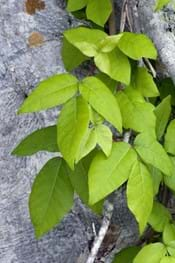
So what causes poison ivy, oak, and sumac rash? A highly concentrated, invisible oil called, urushiol. It exists in all parts of poison ivy, oak, and sumac plants.
Approximately 85% of the population experiences an allergic reaction to these noxious plants. According to the National Institute of Occupational Health & Safety, 50 micrograms of urushiol is enough to cause a rash in 80-90% of adults. That is less than one grain of table salt!
Contact with urushiol
Contact with urushiol can happen in two ways.
The first, direct contact with any part of the plant. Poison ivy plants and poison oak plants can be hard to identify as they can grow in several forms. These noxious plants grow as bushes, ground cover, and creeping vines. Oftentimes, a person comes into contact with them and doesn't even know it.
The second way to come into contact with urushiol is through secondary contamination or indirect contact. Urushiol can last on inanimate objects for a period of months, even years, as it does not evaporate. The next time you come into contact with one of these items, you could develop a rash.
Absorption Rate
Often, after coming into contact with urushiol oil, new spots will appear a day or two (or, more) later. This leads many to believe that the rash is "spreading." But, this may be due to absorption. Because some areas of the body have thicker skin than others, rashes in areas with thicker skin may not appear right away. Urushiol can be absorbed in a slower rate than areas of the body where the skin is thinner.
How Spreading Occurs
If the oil is not properly removed, urushiol can continue to spread to other areas of the body. Typically, urushiol is absorbed within the first 8 hours after exposure, although this can vary. Surprising to many, the liquid that oozes from the blisters of a poison ivy rash does not spread the oil. By the time blisters form, your body has already absorbed the urushiol.
Bathing
After coming into contact with these poison plants, showering rather than taking a bath is always recommended. As soothing as a nice, hot bath may sound, it can potentially make your rash worse. Upon submerging yourself in water, there is a chance that the oil on your skin can lift, and settle on top of the water. This gives the urushiol a chance to spread to other areas of your body. After the first shower using a cleanser such as Tecnu Original Outdoor Skin Cleanser or Tecnu Extreme Poison Ivy Scrub, it is OK to follow up with a bath should you choose.
Hot Water
It is never recommended to take a hot shower immediately after exposure to poison ivy or oak. The reason is, hot water opens your pores. If the pores open up, more urushiol stands a chance of being absorbed into your system. For that reason, showering with cool or lukewarm water for the first shower is best. With the initial shower, we recommend using a cleanser designed to remove urushiol such as Tecnu Extreme Poison Ivy Scrub. After, showers can be taken with hot water.




